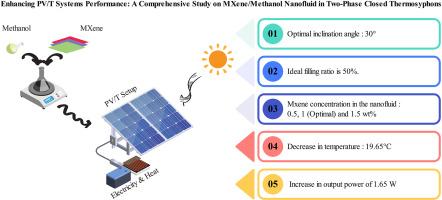Enhancing PV/T systems performance: A comprehensive study on MXene/methanol nanofluid in two-phase closed thermosyphons
IF 6.3
2区 材料科学
Q2 ENERGY & FUELS
引用次数: 0
Abstract
Recent research focuses on utilizing MXene/methanol nanofluid as a working fluid in two-phase closed thermosyphons (TPCT) to enhance cooling for the rear of hybrid solar photovoltaic/thermal (PV/T) systems. The MXene nanosheets offer unique advantages, including high thermal conductivity, capacitive capacity, and hydrophilicity. Additionally, performance and efficiency comparisons between different PV systems are provided. The findings indicate that the optimal inclination angle for the panels is 30°, and a filling ratio of 50 % is ideal. The study shows that using nanofluids at an optimal concentration of 1 % instead of the base fluid leads to a significant reduction in temperature behind the panel, increased electrical output, and enhanced overall efficiency. Specifically, a temperature decrease of 19.65 °C and an electrical output increase of 1.65 W were recorded at a 1 wt% MXene concentration. Thus, this study highlights the impressive performance of PV/T systems when integrated with MXene/methanol nanofluids. Notably, the photovoltaic cell has been made for the first time using this nanofluid.

提高 PV/T 系统性能:两相封闭热流器中的 MXene/甲醇纳米流体综合研究
最近的研究重点是利用 MXene/甲醇纳米流体作为两相封闭式热流器(TPCT)中的工作流体,以提高太阳能光伏/热混合(PV/T)系统后部的冷却效果。MXene 纳米片具有独特的优势,包括高热导率、电容容量和亲水性。此外,还对不同光伏系统的性能和效率进行了比较。研究结果表明,电池板的最佳倾角为 30°,理想的填充率为 50%。研究表明,使用最佳浓度为 1% 的纳米流体代替基液,可显著降低电池板后面的温度,增加电力输出,并提高整体效率。具体而言,在 MXene 浓度为 1 wt% 的情况下,温度降低了 19.65 °C,电力输出增加了 1.65 W。因此,本研究强调了光伏/甲醇系统与 MXene/甲醇纳米流体集成后的卓越性能。值得注意的是,光伏电池是首次使用这种纳米流体制造的。
本文章由计算机程序翻译,如有差异,请以英文原文为准。
求助全文
约1分钟内获得全文
求助全文
来源期刊

Solar Energy Materials and Solar Cells
工程技术-材料科学:综合
CiteScore
12.60
自引率
11.60%
发文量
513
审稿时长
47 days
期刊介绍:
Solar Energy Materials & Solar Cells is intended as a vehicle for the dissemination of research results on materials science and technology related to photovoltaic, photothermal and photoelectrochemical solar energy conversion. Materials science is taken in the broadest possible sense and encompasses physics, chemistry, optics, materials fabrication and analysis for all types of materials.
 求助内容:
求助内容: 应助结果提醒方式:
应助结果提醒方式:


